Are We Diversified?
Are we diversified? The answer is mostly yes. It depends on how you define diversification.
We are reasonably well diversified among the industrial sectors. The following summary from MorningStar X-ray compares our portfolio holdings with the S&P 500.
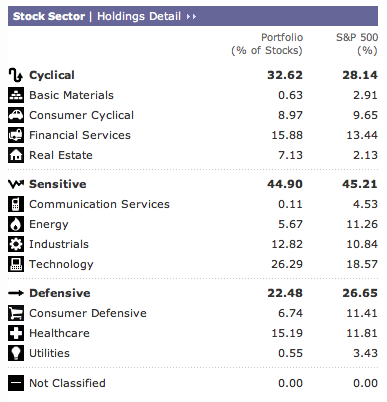
In terms of company size (market capitalization), we are 71% large-cap, 10% mid-cap, and 19% small-cap. In growth vs. value, we are 27% growth, 29% value, and 44% core or blend. Our large-cap holdings lean toward value while our small cap holdings lean toward growth.
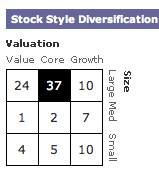
We do have 6% of our portfolio in a real estate investment trust ETF (VNQ). This provides some diversification among asset classes. The only international exposure we have is for those US companies in our portfolio that do business overseas.
To sum it up, we are fairly well diversified among US stocks. We could stand to have a little more mid-cap and small-cap representation in the portfolio. We also could have more international equity exposure. This is probably best done through an index ETF.
Winners and Losers in 2012
We have had an excellent year thus far in 2012. Our annualized return (with only one week to go) is 19.6%. Our total return would be over 20% if our esteemed Congressional representatives would stop playing chicken with the nation’s “fiscal cliff.”
Here are the stocks that contributed to our return. At the top of the list is Apple, despite its precipitous fall from slightly over $700 per share. Our three index funds–representing asset classes which are difficult to buy on a stock-by-stock basis–are all doing well.
Surprisingly, Intel is in negative territory for the year. However the stock selection guide indicates that it is still a “buy”. It’s too bad that it takes so long for the market to understand what we do!
The following table shows our return by stock on an annualized basis. (The actual return your-to-date is slightly lower.) We have held Stryker and Exxon for more than nine months but less than a year.
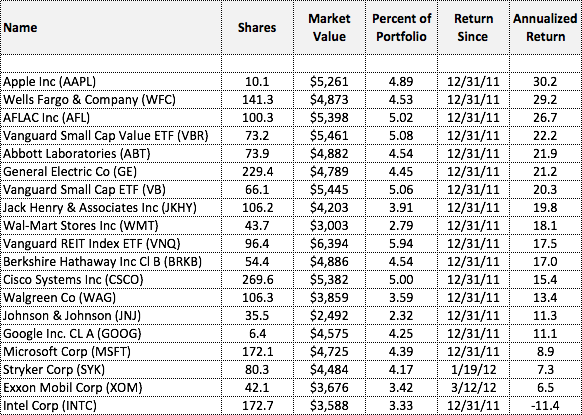
Here is a similar table for the stocks that we have owned for less than 9 months. The table only shows simple return. There are several small stocks in this group. We have taken the approach of buying half positions in small stocks rather than full positions. This gives us some additional diversification by allowing us to hold more small stocks.Â
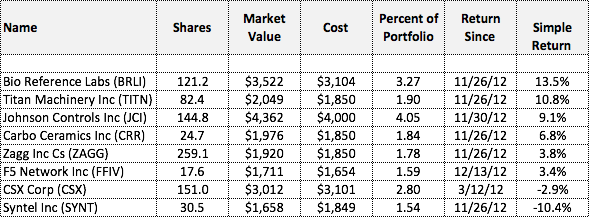
Taking a Long Term View
 Warren Buffet’s annual letter to Berkshire Hathaway shareholders should be mandatory reading for all investors. He not only provides an economic outlook, he explains how Berkshire Hathaway makes money for its shareholders. No other publicly traded company provides the same candor or clear explanation of its operations. (All of the Berkshire Hathaway shareholder letters from 1977 to 2008 can be found here.)
Warren Buffet’s annual letter to Berkshire Hathaway shareholders should be mandatory reading for all investors. He not only provides an economic outlook, he explains how Berkshire Hathaway makes money for its shareholders. No other publicly traded company provides the same candor or clear explanation of its operations. (All of the Berkshire Hathaway shareholder letters from 1977 to 2008 can be found here.)
Between 1965-2008, the book value of Berkshire Hathaway shares grew at compounded annual gain of 20.3%. In comparison, the S&P 500 (including dividends) had a compounded annual gain of 8.9%.
Replacing our low PAR Stocks
Using data from our portfolio dashboard on Manifest Infesting, here are some proposed changes to the portfolio.
First, sort the portfolio by projected average return (PAR) to show which stocks have the highest and lowest PAR. You do this by clicking on the PAR column heading or look at this PDF file. (Place your mouse over the embedded yellow note in the PDF file.)
The six stocks on the bottom (highlighted in yellow in the PDF file) have the lowest projected average return. Looking at these stocks, that is not surprising. Two are bank stocks (WFC and SNV). The current housing market adversely impacts LOW. Similarly, a decrease in consumer spending impacts BBBY and WMT.
We should consider replacing all of these except JNJ. (JNJ is a high quality blue chip stock despite the mediocre PAR. It is a keeper.)
Now we can add to our positions in stocks we already own with stocks that have a higher projected average return than those we are replacing.
Look at again at our portfolio dashboard. Now sort by the value this time, so our largest positions are on top and our smallest positions are on the bottom. Look for stocks for which we don’t yet have a 5% position and which have a projected average return of more than 20%. We can would increase our position in those shares to about 5% or $2,000 total.
This PDF file shows the idea. The candidates for replacement are shown with struck through text. These are the five stocks with the lowest projected average return or PAR. The candidates for additional shares are highlighted in yellow.
There are several additional stocks we may want to consider, including ADBE, AAPL, PCP, and PTR. More to follow on this.
Market Reaction to Earnings Estimates – SNHY
It is always interesting to watch the market reaction to quarterly earnings reports. Small variances between reported earnings and analyst expectations, especially in growth stocks, frequently result in sharp price fluctuations. More often than not, the change in price has nothing to do with the underlying business model of the company. A case in point is Sun Hydraulics, one of our holdings.
Sun Hydraulics Corp., SNHY, reported Q2 (June) earnings of $0.54 per share, $0.04 better than the First Call consensus of $0.50. Quarterly revenues rose 18.8% year over year to $51.6M vs. the $51.4M analyst consensus. (Q3 earnings press release.)
However, the company reduced its outlook for Q3, projecting EPS of $0.35-0.37 which is slightly lower than the $0.42 analyst consensus. The company also projected Q3 revenues of $45M which is slightly lower than $47.93M analysis consensus. Here is the company’s statement regarding Q3.
“Sun’s products are used in diversified equipment markets around the globe,” stated Carlson. “Many of these markets, such as mining and energy, remain strong and demand is high. In other more obvious markets, such as equipment used in residential and commercial construction, we have begun to see some softening.”
“The diversity of our end markets, both geographically and the segments we participate in, is pivotal to maintaining our growth,” concluded Carlson.
2008 third quarter sales are estimated to be approximately $45 million, a 9% increase over last year. Third quarter earnings per share are estimated to be between $0.35 and $0.37 per share, compared to $0.32 per share last year. EPS estimates for the third quarter include a charge of $775K for U.S. income taxes due on the repatriation of $6 million from Sun Germany in July 2008.
This slightly reduced guidance caused the stock to drop 11.24% on August 5 after it announced its earnings.
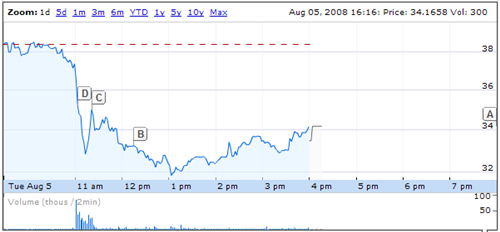
Here is an updated stock selection guide that incorporates the Q3 data. It use a conservative estimated of 18% for revenue and sales growth. It also uses a conservative 5-year average average P/E of 16.9. The SSG still shows a projected average return of 13.7%. The fundamental business model of the company has not changed. It is still a strong hold. Despite teh drop in price yesterday, we have a 17.2% annualized return on SNHY.
Transocean Inc. (RIG)
If the current high price of crude oil reflects a fundamental change in the world-wide demand for oil, as many suggest (see Sunday Washington Post article), then prospects may be bright for oil services stocks. We have one oil services stock in our portfolio, Helmerich & Payne (HP). The stock is at $52.90 per share, up from the $33.72 we paid for it last June. HP is 6.8% of our portfolio. HP provides contract drilling services to oil and gas producers primarily in the United States, Argentina, Colombia, Ecuador, and Venezuela.
It might be wise to diversify and include deep water drilling company. Transocean Inc. (RIG) pops up in numerous screens and articles. Value Line describes Transocean as the world’s largest offshore drilling contractor, working in all the major offshore regions, including the Gulf of Mexico, the North Sea, the Middle East, and off the coasts of West Africa, the United Kingdom, Norway, Brazil, and Canada. It specializes in technically demanding deep-water/harsh-environment drilling projects.
Here is a stock selection guide for Transocean. Manifest Investing estimates a projected average return of 19.3%. Morningstar rates Transocean 5-stars (undervalued) and calculates fair vale as $176 (current price is $133). We should consider selling part of our position in HP and buying RIG.
Maxim Integrated Products
Maxim Integrated Products (MXIM or MXIM.PK) has been one of our disappointing holdings. We bought an initial position in February 2005 at $39.44 per share and added to that position in June 2006 at $31.33 per share thinking the worst was over for the stock. The stock is currently priced at $18.35, down from its $55 high in 2004.
Maxim got caught up in an options backdating scandal. Nasdaq delisted it. And it has taken the company a long time to restate its financials, which has resulted in significant legal and accounting fees.
Barron’s reports today:
Now there are signs that the worst may be over. The company, with a market value of $6 billion, has submitted revised financial statements to its auditors. Earnings are expected to pick up next year, as the legal expenses of the probe recede into the past. And conditions in the chip industry could start to improve markedly within a couple of years.
Result: The stock could rocket by more than 40%. The hope is that growth investors, who abandoned the shares over the past couple of years, will start returning in force. What they’ll find is a stock that trades at a sharp discount to its peers and boasts $1.2 billion of cash and no debt.
Value Line stopped covering Maxim when it was delisted. However, Morningstar still follows the company and rates it 5-stars (undervalued) and gives it a fair value estimate of $34. Here are some excerpts from the Morningstar Report from May:
We consider Maxim Integrated Products one of the better long-term semiconductor investments. With attractive products, sought-after talent, and a plausible plan for growth, Maxim should continue generating healthy returns on invested capital for many years. …Â Maxim is well positioned in its core business of high-performance analog (HPA) chips, which are complex and proprietary by nature. Armed with one of the most talented design teams in the industry, Maxim has been able to produce superior designs that command a price premium. … We now expect Maxim to grow sales at a compound annual rate of 8.2% for the next seven years, down from the 13% assumption used in our previous model. Although we expect the consumer business to be highly competitive, we think Maxim’s gross margins will likely remain in the low 60s. … We forecast operating margins in the low 30s.
Until the SEC approves its revised financial statements, Maxim is limited on the information it may release publicly. This makes analysis of the company difficult.
Maxim will release financial results for the fourth quarter of its 2008 fiscal year on Thursday, August 7, 2008. A video replay of the earnigns conference can be found on the investors section of the Maxim website.
Some Portfolio Adjustments?
Here is the Public Dashboard from Manifest Investing for the Moose Pond portfolio. Overall, the portfolio shows a projected average return of 15.6% and a quality rating of 72.2. The dashboard is forward looking. Manifest Investing uses data from Value Line, Yahoo Finance, and other sources to estimate revenue growth, profit margins, and P/E five years out. From this projected data is is easy to project earnings per share and the future price (P/E x EPS). So the dashboard provides a method of comparing stocks within the portfolio. Note that the amount for a given stock is irrelevant in this analysis. What the company might do going forward counts.
Looking across the Moose Pond portfolio, we see a few stocks that warrant a close look.
- Helmerich & Payne has a PAR of 5.7%. This oil field services company has had a good run and is up 78% since we purchased it last June. It is 6.2% of the portfolio. We could take a small profit and sell some of this stock.
- Brown & Brown has been a relatively unexciting holding. We purchased in March 2004. It is down 10% and represents about 1.4% of the portfolio. We might want to consider replacing it.
- AIG has been the worst performer in the portfolio (and a good example of why diversification is so important). It is down 64% since we bought it last June. This is one of those financial stocks that will turn when the financial sector finally does. At some point we may want to add to our AIG holding, if we don’t purchase Berkshire Hathaway.
- We might want to increase our position on few sticks with high PARs, Lowes (21.6%) and Garmin 26.7%. Lowes is 2.5% of our portfolio and Garmin is 1.4%.
Take a close look at the portfolio dashboard and the portfolio valuation report at Bivio.com. We need to make some adjustments to our portfolio.
Berkshire Hathaway
Berkshire Hathaway is usually categorized by analysts as a property & casualty insurance company. It is actually an incredibly interesting, diverse, and successful holding company made up of 10 insurance companies and 66 non-insurance businesses. These diverse and well managed businesses include See’s Candies, NetJets, Flight Safety Safety International, Borsheim’s Jewery, Fruit of the Loom, GEICO Auto Insurance, Benjamin Moore & Co., Dairy Queen, Clayton Homes, and Johns Manville. (See complete list of Berkshire Hathaway businesses.) Berkshire Hathaway also has an investment portfolio valued in excess of $75B.
In 2007, Berkshire Hathaway’s annual revenues totaled $118B. To put their businesses in perspective, insurance premiums were $31.8B while sales and services revenue from the non-insurance businesses was $58.2B. So calling Berkshire an insurance company is not very accurate, but insurance is one of its core businesses.
At the end of 2007, assets for the various Berkshire insurance companies included $39.8B in cash and $86.8B in equities and fixed maturity instruments. These assets include reserves for anticipated covered losses. For the non-insurance businesses, cash and fixed maturity instruments totaled $8.8B. Together, these assets give Berkshire the ability to internally finance its operations. It provides the cash to acquire new businesses. This cash also gives Berkshire the ability to add substantial positions to its investment portfolio.
The breadth of Berkshire’s business and investment holdings make it difficult for analysts to perform cash flow analysis and to estimate earnings. As you can see from the attached file, the Value Line assessment differs from that of Morningstar. (Morningstar appears to be more on the mark although they don’t do a good job explaining their discounted cash flow analysis.)
Warren Buffet and Charlie Munger have managed Berkshire Hathaway form the beginning in 1964. Integrity, honesty, and business acumen have been the hallmarks of their stewardship over the past 43 years. They have set the gold standard for corporate openness and transparency. Their results are unmatched. Share prices have compounded at rate of 21.1% between 1964-2007.  The sheer size of Berkshire Hathaway today will probably prevent it from achieving this high rate of return in the future. Nonetheless, Berkshire shareholders can expect to do well.
Warren Buffet’s annual letters to shareholders can be found here. They should be mandatory reading for every investor.
Morningstar rates Berkshire Hathaway five-stars with a fair market value of $5,100 (for the class B shares, BRK.B). Current price as of this posting is $3,914. Manifest Investing estimates projected average return of 17.5%. Here is a completed stock selection guide for Berkshire Hathaway.
Note: Berkshire Hathaway has two classes of shares. The “B” share ($3,914) is valued at 1/30 of the “A” share ($117,290). Berkshire Hathaway has never paid a dividend or authorized a stock split, so the 21.1% compound annual growth is reflected in the high price of the stock.
Berkshire Hathaway is an excellent core holding. We should consider purchasing purchasing one of the “B” shares with our available cash.
Portfolio Update
As of this past Friday, we survived the market turmoil. The internal rate of return for Moose Pond Investors was 2.4% for the year to date. This slightly lagged the S&P 500, which was up 4.3% for the same period. See performance report.
Several stocks accounted for the mediocre performance.
Getty Images GYI (-38%) had a disappointing quarterly earnings report. Morningstar star reduced its fair market value estimate. Investors Advisory service recommends selling GYI, noting that the company faces increased competition in the Internet photo images market. Morningstar reduced GYI’s moat rating from “wide” to “narrow.” The visual section of the stock selection guide show the downturn. See the current stock selection guide (SSG) which shows a projected average return (PAR) of only 7.6%. My bad for recommending this one. We should probably sell GYI at some point soon.
Amgen AMGN (-26.6%) has been down for the year. However, most of the analyst reports cite its pipeline and consider it a strong long term buy. Here is the current AMGN SSG. Note that the PAR of 22.7% and that assumes a relatively modest EPS growth of 11%. AMGN is definitely a hold and probably a buy. Now if the market will just recognize what we do!
Of course we had several winners YTD as well. These include INTC (+23.7%), ITW (+24.9%), JKHY (+25.2%), and OXY (+27.8%). This highlights the importance of diversification.
Here are three transactions that may improve our portfolio performance for this year.
- Replace Stryker (SYK) with Medtronics (MDT). Stryker has advanced 22% this year. The price increase has diminished its long term prospects. Morningstar rates it two stars (a little over priced). In contrast MDT is rated five stars (a bargain). Both companies are quality medical suppliers, however, the prospects are a little better for MDT.
- Sell Getty Images (GYI). We are better off selling and redeploying the cash.
- Buy Superior Energy Services (SPN). BNP Is a diversified provider of specialized oilfield services and equipment. While oilfield services are cyclical, the prices for oil and gas have not gone down and the demand for oilfield services continues. The SSG for SPN looks strong. Neither Morningstar nor Value Line cover SPN, but it received a five star rating from Standard & Poors. We should move quickly on SNP as it appears particularly undervalued now.